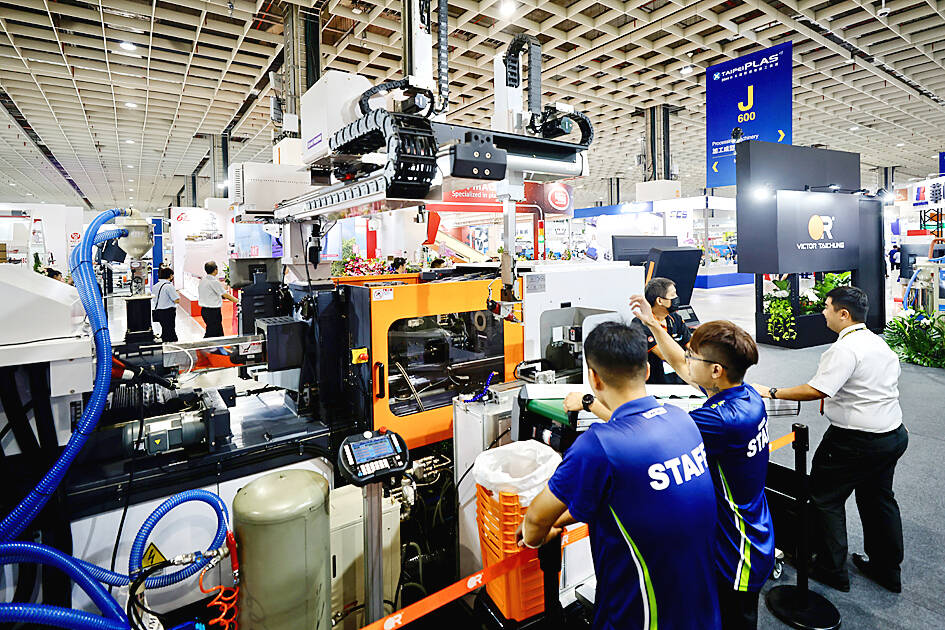Operating conditions for Taiwanese manufacturers fell last month amid lingering economic weakness in the US, Europe and China, the Chung-Hua Institution for Economic Research (CIER, 中華經濟研究院) said yesterday.
The official manufacturing purchasing managers’ index (PMI) shed 4.4 points to 49.2, dropping back into contraction territory, as companies turned from cautious to conservative regarding their business prospects, CIER president Lien Hsien-ming (連賢明) said.
“The subindices on new business orders, industrial production and business outlook all declined into the contraction zone, which could suggest a turning point,” Lien said.

Photo: Ritchie B. Tongo, EPA-EFE
PMI data aim to measure the health of the manufacturing industry. Values of 50 or higher indicating expansion, while values below the threshold suggest contraction.
The sentiment shift had to do with the market’s lack of enthusiasm over global sales of iPhone 16s and a stall in demand for electronics used in artificial intelligence (AI) applications, Lien said.
That explained why the critical subindex on new orders lost 8.2 points to 48.5, while the measure on industrial output tumbled 10.6 points to 46.8, the institute said in its monthly survey.
New export orders sank 8.2 points to 44.6, while unfinished orders dropped 5.9 points to 43.5, the survey showed.
PMI readings already pointed to a slowdown in the US, Europe and China, Lien said, adding that oil exporters last month trimmed their sales forecasts.
CIER researcher Chen Shin-hui (陳馨蕙) said that the absence of a growth catalyst accounted for the lackluster showings, despite the onset of the high season for technology products.
The reading on the six-month business outlook shrank 5.3 points to 47.5, putting an end to seven months of optimism, the survey showed.
CIER vice president Wang Jiann-chyuan (王健全) said that AI is in a bit of a bubble, which would be seen in last month’s shipments.
A Chinese ban on Nvidia Corp chips also would affect local firms in its supply chain, Lien said.
Taiwanese firms would need more time to judge whether rate cuts by the US Federal Reserve and stimulus measures in China would shore up the world’s two largest economies, he said.
Taiwan’s non-manufacturing sectors also experienced a slowdown, but remained at healthy levels, CIER said in a separate survey, as the non-manufacturing index lost 1.2 points to 53.3.
The PMI slowdown weighed on shipping rates and new credit controls by Taiwan’s central bank dampened buying interest at home, CIER said.
However, most service providers are positive about their business going forward, keeping the reading on the six-month outlook at 53.1, it said.

CHIP RACE: Three years of overbroad export controls drove foreign competitors to pursue their own AI chips, and ‘cost US taxpayers billions of dollars,’ Nvidia said China has figured out the US strategy for allowing it to buy Nvidia Corp’s H200s and is rejecting the artificial intelligence (AI) chip in favor of domestically developed semiconductors, White House AI adviser David Sacks said, citing news reports. US President Donald Trump on Monday said that he would allow shipments of Nvidia’s H200 chips to China, part of an administration effort backed by Sacks to challenge Chinese tech champions such as Huawei Technologies Co (華為) by bringing US competition to their home market. On Friday, Sacks signaled that he was uncertain about whether that approach would work. “They’re rejecting our chips,” Sacks

Taiwan’s long-term economic competitiveness will hinge not only on national champions like Taiwan Semiconductor Manufacturing Co. (TSMC, 台積電) but also on the widespread adoption of artificial intelligence (AI) and other emerging technologies, a US-based scholar has said. At a lecture in Taipei on Tuesday, Jeffrey Ding, assistant professor of political science at the George Washington University and author of "Technology and the Rise of Great Powers," argued that historical experience shows that general-purpose technologies (GPTs) — such as electricity, computers and now AI — shape long-term economic advantages through their diffusion across the broader economy. "What really matters is not who pioneers

In a high-security Shenzhen laboratory, Chinese scientists have built what Washington has spent years trying to prevent: a prototype of a machine capable of producing the cutting-edge semiconductor chips that power artificial intelligence (AI), smartphones and weapons central to Western military dominance, Reuters has learned. Completed early this year and undergoing testing, the prototype fills nearly an entire factory floor. It was built by a team of former engineers from Dutch semiconductor giant ASML who reverse-engineered the company’s extreme ultraviolet lithography (EUV) machines, according to two people with knowledge of the project. EUV machines sit at the heart of a technological Cold

TAIWAN VALUE CHAIN: Foxtron is to fully own Luxgen following the transaction and it plans to launch a new electric model, the Foxtron Bria, in Taiwan next year Yulon Motor Co (裕隆汽車) yesterday said that its board of directors approved the disposal of its electric vehicle (EV) unit, Luxgen Motor Co (納智捷汽車), to Foxtron Vehicle Technologies Co (鴻華先進) for NT$787.6 million (US$24.98 million). Foxtron, a half-half joint venture between Yulon affiliate Hua-Chuang Automobile Information Technical Center Co (華創車電) and Hon Hai Precision Industry Co (鴻海精密), expects to wrap up the deal in the first quarter of next year. Foxtron would fully own Luxgen following the transaction, including five car distributing companies, outlets and all employees. The deal is subject to the approval of the Fair Trade Commission, Foxtron said. “Foxtron will be